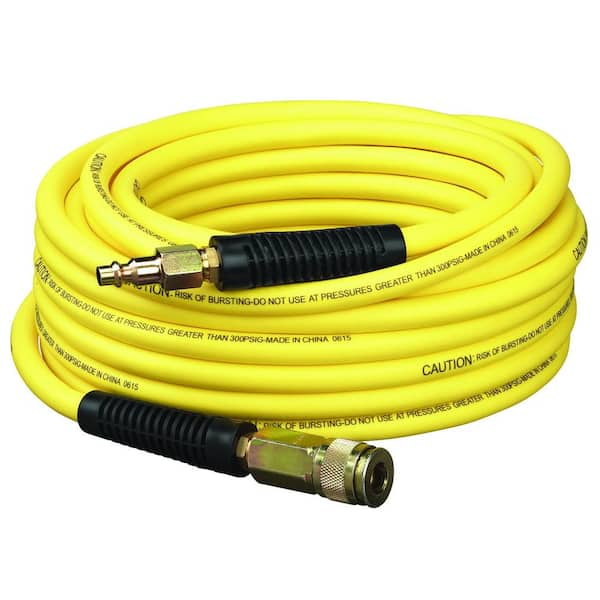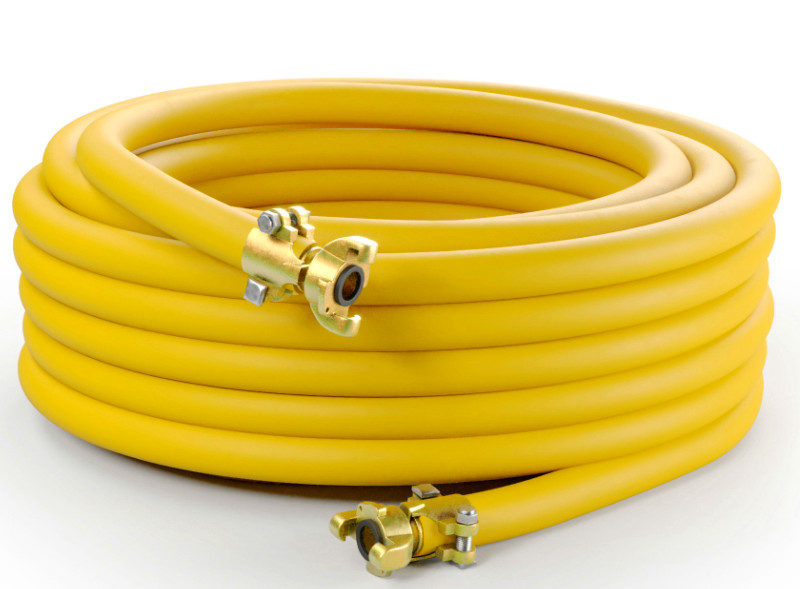A compressor air hose is a flexible tube that connects an air compressor to pneumatic tools. It transports compressed air efficiently for various applications.
Understanding the role of a compressor air hose is crucial for anyone involved in DIY projects or professional work. These hoses come in various lengths and diameters, allowing for flexibility in how you use them. Choosing the right hose enhances the performance of your air tools and ensures safety during operation.
Quality materials, such as rubber or polyurethane, can improve durability and resistance to wear and tear. Regular maintenance, including checking for leaks or damage, extends the life of your hose. Investing in a reliable compressor air hose is essential for maximizing productivity and achieving optimal results in any task.

Credit: www.amazon.com
Introduction To Compressor Air Hoses
Compressor air hoses are vital in compressed air systems. They transport air from the compressor to tools and equipment. Choosing the right air hose ensures efficiency and safety. Understanding their role and characteristics helps make informed decisions.
The Role Of Air Hoses In Compressed Air Systems
Air hoses serve several important functions in compressed air systems:
- Transport Air: They carry compressed air to various tools.
- Maintain Pressure: A good hose helps maintain consistent air pressure.
- Flexibility: They allow movement around workspaces easily.
- Durability: Quality hoses withstand wear and tear over time.
Key Characteristics Of Quality Air Hoses
Choosing the right air hose involves understanding its key features:
| Characteristic | Description |
|---|---|
| Material | Common materials include rubber, PVC, and polyurethane. |
| Diameter | A larger diameter allows for better airflow. |
| Length | Longer hoses provide flexibility but may reduce pressure. |
| Pressure Rating | Choose hoses that can handle higher pressures safely. |
| Temperature Resistance | Hoses must withstand varying temperatures without damage. |
Consider these characteristics for optimal performance and safety. Select a hose that meets your specific needs.
Types Of Compressor Air Hoses
Choosing the right compressor air hose is essential for efficiency. Different types of hoses cater to various needs. Understanding the options helps in making an informed choice.
Material Varieties: Rubber, Pvc, Polyurethane
Compressor air hoses come in several materials. Each material has unique features:
| Material | Durability | Flexibility | Weight |
|---|---|---|---|
| Rubber | Highly durable | Less flexible | Heavy |
| PVC | Moderately durable | Very flexible | Lightweight |
| Polyurethane | Highly durable | Extremely flexible | Very lightweight |
Rubber hoses are tough. They withstand wear and tear well. PVC hoses are light and flexible. They are easy to handle. Polyurethane hoses offer the best of both worlds. They are strong yet lightweight.
Differences In Hose Diameter And Length
Hose diameter and length impact air flow and pressure. Consider these factors:
- Diameter:
- Common diameters range from 1/4 inch to 1 inch.
- A larger diameter allows more air flow.
- A smaller diameter is better for precision tasks.
- Length:
- Lengths vary from 25 feet to 100 feet.
- Longer hoses provide more reach.
- Shorter hoses increase pressure but limit mobility.
Choosing the right diameter and length is vital. It ensures optimal performance for your compressor. Assess your needs carefully before purchasing.
Choosing The Right Hose For Your Compressor
Choosing the right hose for your compressor is essential. A suitable hose ensures efficiency and safety. It also affects the performance of your tools. Understanding key factors helps you make the best choice.
Assessing Pressure Ratings And Compatibility
Pressure ratings are crucial for selecting a hose. Each hose has a maximum pressure limit. Exceeding this limit can lead to dangerous situations. Here are some key points to consider:
- Check the compressor’s PSI rating: Match it with the hose’s rating.
- Material matters: Some materials handle pressure better than others.
- Length impacts pressure: Longer hoses can reduce pressure. Choose a length that suits your needs.
Ensure the hose fits your tools. Different tools may require different fittings. Compatibility prevents leaks and ensures proper operation.
Considerations For Indoor Vs. Outdoor Use
The environment affects hose selection. Indoor and outdoor conditions differ significantly. Here are some factors to consider:
| Factor | Indoor Use | Outdoor Use |
|---|---|---|
| UV Resistance | Not necessary | Essential for durability |
| Temperature Range | Stable conditions | Needs to withstand extremes |
| Flexibility | Less movement | High flexibility required |
Choose hoses designed for specific environments. This ensures longevity and effectiveness.
Connection Matters: Fittings And Couplings
Fittings and couplings are vital for a reliable compressor air hose. They ensure a tight seal and prevent air leaks. Choosing the right fittings impacts performance and safety.
Securing An Airtight Connection
An airtight connection is crucial for effective air flow. Leaks waste energy and decrease efficiency. Here are some tips to secure a strong connection:
- Use high-quality fittings.
- Ensure all threads are clean.
- Tighten connections properly.
- Check for wear and tear regularly.
Types Of Hose Fittings: Pros And Cons
Different types of hose fittings suit various needs. Understanding their pros and cons helps in making an informed choice.
| Type of Fitting | Pros | Cons |
|---|---|---|
| Threaded Fittings |
|
|
| Quick-Connect Fittings |
|
|
| Barbed Fittings |
|
|
Select the right fitting type for your needs. Ensure your compressor air hose performs at its best.
Maximizing Airflow With Proper Hose Setup
To ensure your air compressor works efficiently, setting up the hose correctly is vital. Proper hose setup maximizes airflow and boosts performance. Avoiding twists and kinks in the hose is crucial. The length and diameter of the hose also play significant roles.
Avoiding Twists And Kinks
Twists and kinks can block airflow. Here are simple tips to prevent them:
- Store hoses in a straight position.
- Use hose reels for easy storage.
- Check for twists before use.
Always ensure the hose is laid out flat. This practice prevents unnecessary wear and tear. Smooth airflow leads to better tool performance.
The Impact Of Length And Diameter On Performance
The length and diameter of your air hose affect airflow significantly.
| Hose Length (feet) | Recommended Diameter (inches) | Airflow Impact |
|---|---|---|
| 25 | 1/4 | Optimal performance |
| 50 | 3/8 | Good performance |
| 100 | 1/2 | Reduced performance |
Shorter hoses reduce pressure drop. Wider hoses improve airflow. Use the right combination for your needs. Always check compatibility with your tools.
Proper hose setup ensures you maximize your compressor’s efficiency. Follow these guidelines for the best results.
Maintenance Best Practices
Proper maintenance of your compressor air hose ensures long-lasting performance. Regular care prevents costly repairs and replacements. Follow these best practices for optimal results.
Regular Inspection For Wear And Tear
Inspect your compressor air hose frequently. Look for signs of damage, such as:
- Cracks or splits
- Bulges or lumps
- Corrosion
- Loose fittings
Conduct visual checks before each use. Pay attention to pressure ratings. Replace any damaged hoses immediately to avoid accidents.
Cleaning Techniques For Longevity
Keeping your air hose clean extends its lifespan. Follow these simple cleaning techniques:
- Rinse the hose with clean water.
- Use a mild detergent to remove dirt.
- Dry the hose completely before storage.
Store the hose in a cool, dry place. Avoid direct sunlight and extreme temperatures. Regular cleaning prevents buildup and maintains flexibility.
Troubleshooting Common Air Hose Issues
Air hoses are essential for various tasks. They can face issues over time. Understanding common problems helps in quick fixes. This guide covers leaks, blockages, and repairs.
Dealing With Leaks And Blockages
Leaks and blockages are frequent problems with air hoses. Here’s how to identify and fix them:
- Identifying Leaks:
- Listen for hissing sounds.
- Feel for air escaping.
- Use soapy water to spot bubbles.
- Common Blockage Causes:
- Dirt and debris in the hose.
- Twists or kinks in the line.
- Frozen air in colder weather.
How To Repair Damaged Hoses
Repairing damaged hoses can save money. Follow these steps for effective repairs:
- Locate the Damage: Inspect the entire hose.
- Cut Out the Damaged Section: Use a sharp knife.
- Join the Pieces:
- Use a hose connector.
- Seal with tape for extra protection.
- Test the Repair: Check for leaks before use.
Regular checks can prevent bigger issues. Keep your air hose in good condition.

Credit: www.homedepot.com
Advanced Tips For Professionals
For professionals, optimizing your compressor air hose is essential. Customization and innovation enhance performance. These tips ensure efficient use and longevity of your hoses.
Customizing Hoses For Specific Applications
Every task requires a unique approach. Customize your hoses based on the following factors:
- Length: Ensure the hose is long enough for your needs.
- Diameter: Choose the right diameter for optimal airflow.
- Material: Select materials suitable for your environment.
- Fittings: Use compatible fittings for secure connections.
Consider the following table for common applications:
| Application | Recommended Length | Recommended Diameter |
|---|---|---|
| Painting | 25-50 ft | 1/4 inch |
| Sandblasting | 50-100 ft | 3/8 inch |
| Pneumatic Tools | 15-30 ft | 1/4 inch |
Innovations And Upgrades In Hose Technology
Recent advancements in hose technology enhance performance. Key innovations include:
- Reinforced Materials: Increases durability and reduces wear.
- Flexible Designs: Improves maneuverability in tight spaces.
- Temperature Resistance: Allows operation in extreme conditions.
Upgrades to consider:
- Switch to anti-static hoses to prevent shock.
- Use quick-connect fittings for easy attachment.
- Implement hose reels for better storage and management.
Stay updated on trends in hose technology. Embrace new materials and designs for enhanced efficiency.

Credit: www.somaxflex.com
Frequently Asked Questions
What Is A Compressor Air Hose?
A compressor air hose is a flexible tube designed to transport compressed air from a compressor to various tools and equipment. These hoses come in various lengths and diameters to suit different applications. Choosing the right hose ensures efficient air flow and minimizes pressure loss during use.
How Do I Choose The Right Air Hose?
To choose the right air hose, consider the length, diameter, and material. The hose should match your compressor’s specifications. Additionally, think about the intended use—light-duty tasks may require a different hose than heavy-duty applications. Always check for compatibility with your tools to ensure optimal performance.
What Are Common Air Hose Sizes?
Common air hose sizes include 1/4 inch, 3/8 inch, and 1/2 inch in diameter. The size you choose depends on the air tool requirements and the compressor output. Larger diameters allow for more air flow but may be bulkier. Always select a size that balances flexibility and performance.
Can I Use Any Hose With My Air Compressor?
No, not all hoses are compatible with air compressors. It’s essential to use hoses specifically designed for compressed air. Regular garden hoses may not withstand high pressure and could burst. Always check the hose’s specifications to ensure it can handle the compressor’s output.
Conclusion
Choosing the right compressor air hose is crucial for efficiency and safety. Consider factors like material, length, and pressure rating. A quality hose enhances performance and extends the life of your equipment. Invest wisely for the best results. With the right hose, your projects will run smoothly and effectively.

